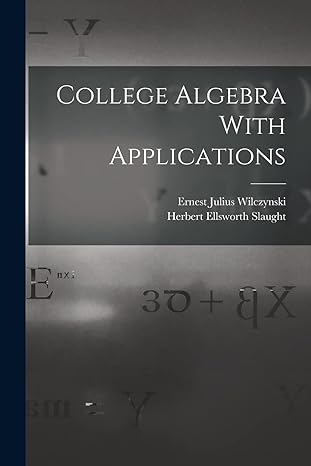Answered step by step
Verified Expert Solution
Question
1 Approved Answer
Appendix A Homework 1) The following function written in pseudocode accepts INCOME as a variable and outputs the TAX corresponding to that income. FUNCTION TAX
Appendix A Homework 1) The following function written in pseudocode accepts INCOME as a variable and outputs the TAX corresponding to that income. FUNCTION TAX (INCOME) 1. IF (INCOME > 60000) THEN a. TAXDUE 15000 2. ELSE a. IF (INCOME > 30000) THEN 1. TAXDUE 5000 b. ELSE 1. TAXDUE INCOME 0.08 3. RETURN (TAXDUE) What would the pseudocode output with an input of: a) 23000? b) 64000? c) 47000? 2) Suppose that the array X consists of real numbers X[1], X[2], the array Y consists of the real numbers Y[1], Y[2], and the array Z consists of the real numbers Z[1], Z[2]. What does the following algorithm compute? 1. LSUM 0 2. FOR I = 1 THRU 2 a. LSUM LSUM + (X[I])(Y[I])(Z[I]) 3) Consider the following algorithm; assume N to be a positive integer. 1. X 0 2. Y 0 3. WHILE (X < N) a. X X+2 b. Y Y+X 4. Y Y/N What will this algorithm compute when N = 2? N = 5? Section 1.4 Homework 1) Write m as qn+r, with 0 < r < n for parts a) through c). a) m = 75, n = 13 b) m = 13, n = 75 Homework c) m = 44, n = 11 2) Write the integer as a product of powers of primes. a) 179 b) 244 3) Find the greatest common divisor d of the integers 58 and 124, and write d as s(58) + t(124). Write out all of the steps. 4) Use the fact that GCD(a,b)LCM(a,b)=ab to compute the least common multiple of 58 and 124, LCM(58,124). 5) If f is the mod-5 function, compute each of the following: a) f(13) + f(19) b) f(13+19) c) f(278) 6) Use Bacon's code to create a dummy message for ABANDON. For the sake of simplicity, use bold font for 0 and regular font for 1. Homework Section 2.4 Homework 1) Prove that 3+6+ 9+ ...+3 n= 3 n(n+ 1) 2 Here is a general outline you can use. 1. Basis step. Prove P(1) 2. Induction step. a. Write out P(k) by replacing \"n\" with \"k\" in the original equation. b. Now, we must look at P(k+1). To do this, modify your P(k) expression from part 2a by adding the \"k+1\"st term to the left hand side and replace \"k\" with \"k+1\" on the right hand side. This is what we need to show. c. Using the assumption that P(k) is true, replace the \"1 through k\" portion on the left hand side of the P(k+1) equation you wrote in part 2b. d. If necessary, multiply away any constant denominators in the new P(k+1) formulation. e. Multiply out the left-hand side and the right-hand side to establish the equality
Step by Step Solution
There are 3 Steps involved in it
Step: 1

Get Instant Access to Expert-Tailored Solutions
See step-by-step solutions with expert insights and AI powered tools for academic success
Step: 2

Step: 3

Ace Your Homework with AI
Get the answers you need in no time with our AI-driven, step-by-step assistance
Get Started


